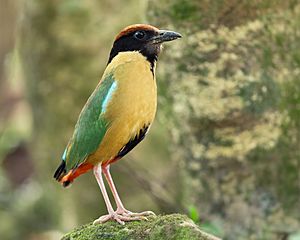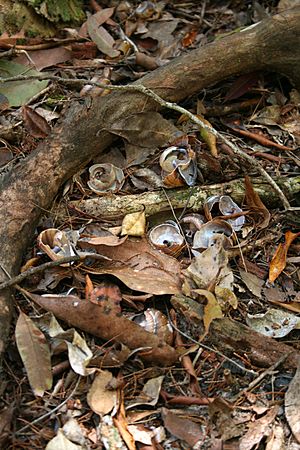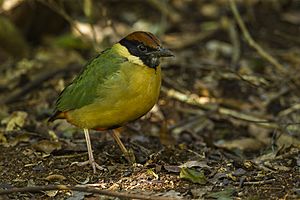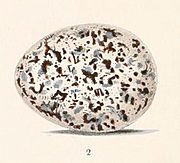Noisy pitta facts for kids
The noisy pitta (Pitta versicolor) is a colorful bird found in eastern Australia and southern New Guinea. It's known for its bright feathers and its loud call. This bird loves to eat earthworms, insects, and snails. You can usually find it in warm, wet forests.
Quick facts for kids Noisy pitta |
|
|---|---|
 |
|
| Conservation status | |
| Scientific classification | |
| Genus: |
Pitta
|
| Species: |
versicolor
|
| Synonyms | |
|
Pitta strepitans |
|
Contents
About the Noisy Pitta's Name
The noisy pitta is a type of bird in the Pittidae family. Some people think it's closely related to other pitta species. These include the elegant pitta from Indonesia and the rainbow pitta from northern Australia.
The bird was first described in 1825 by William Swainson. He named it versicolor, which is a Latin word meaning "multicoloured." This name fits the bird's bright feathers very well!
There are two main types, or subspecies, of the noisy pitta. One lives in northern Queensland and the Torres Strait islands. These birds sometimes fly to southern Papua New Guinea. The other type lives in the rest of Queensland and goes south into New South Wales.
People sometimes call the noisy pitta by other names. These include the buff-breasted pitta or the lesser pitta. It was also known as the "anvil-bird" because of how it eats.
What Does a Noisy Pitta Look Like?
The noisy pitta is a very colorful bird. It grows to be about 19 to 21 centimeters (7.5 to 8.3 inches) long. Males usually weigh between 70 and 112 grams (2.5 to 4 ounces). Females are a bit heavier, weighing 70 to 128 grams (2.5 to 4.5 ounces).
This bird has a black head and the back of its neck. Its crown, which is the top of its head, is chestnut brown. Its wings are green with a bright turquoise front edge. The bird's back is also green.
The noisy pitta's throat, chest, and belly are a bright lemon yellow. Its tail is black. The feathers under its tail are a striking orange-red color.
Young noisy pittas look similar to adults. However, their colors are not as bright. Their wings have more olive green, and their chest and throat are a duller gray.
Where Do Noisy Pittas Live?
Noisy pittas live in forest areas along the east coast of Australia. You can find them from the Torres Strait Islands down to the border of New South Wales and Victoria. They mostly live in rainforests. Sometimes, they are also seen in drier woodlands.
Outside of Australia, noisy pittas can be found in southern New Guinea. They might be winter visitors there, or they could even breed in those areas.
Noisy Pitta Behaviour

The noisy pitta is a shy bird. You are more likely to hear its distinctive call than to see the bird itself. Because they are so quiet when not calling, people might often miss them.
Noisy Pitta Calls
Noisy pittas call most often in the morning. They also have another time when they call a lot around midday. Their calling slows down in the afternoon. Then, it picks up again at dusk. They even call at night sometimes!
These birds call most during their breeding season. From March to August, you will hear almost no calls from them.
Their call is usually repeated twice. It sounds like three notes going up, sometimes described as "walk-to-work."
What Do Noisy Pittas Eat?
Noisy pittas spend their time on the forest floor. They search through fallen leaves and dirt for food. They eat insects, woodlice, snails, and other small creatures.
When they are looking for food, they bob their head up and down. They also flick their tail from side to side. Their diet also includes some fruit.
A cool thing about noisy pittas is how they eat snails. They crack open the shells of molluscs, like the giant panda snail, on a hard surface. This hard surface, like a stone, is called an "anvil." They use the same anvil over and over again. They also catch small lizards and hit them against hard surfaces before swallowing them.
Noisy Pitta Reproduction and Life Cycle
Like other pittas, this bird builds its nest in a hidden spot on the ground. The breeding season is usually in late spring and early summer. However, the exact timing can change depending on where the birds live.
In southern areas, eggs are laid between July and February. The busiest time for laying eggs is in November. Further north, around Cape York, the season is shorter, from November to February. The busiest time there is January. These differences might be due to rainfall patterns. Breeding usually happens about two months before the heaviest rains. This helps make sure there is plenty of food for the young birds when they leave the nest. It also helps ground nests avoid floods.
The nest is shaped like a dome. It is about 30 by 30 by 20 centimeters (12 by 12 by 8 inches). Nests are usually placed on the ground. They are often at the bottom of a large rock, tree stump, or roots. Sometimes, nests have been found in trees, up to 2.7 meters (9 feet) off the ground.
The nest is made from small branches, twigs, roots, and plant fibers. It also uses mosses, strips of bark, and feathers. The inside of the nest is lined with soft grass and other fine plant material. Parents often bring new lining material during incubation. Some nests even have a small ramp made of sticks leading to the entrance. Animal droppings are sometimes placed at the entrance and inside the nest. Both parents help build the nest.
A female noisy pitta usually lays between two and five eggs. Birds in Cape York lay about 3 eggs. Birds in the southern part of their range often lay 4 eggs. The eggs are about 32 by 25 millimeters (1.3 by 1 inch) in size. Eggs laid further south tend to be larger. Eggs laid later in a clutch are smaller than the first ones. The eggs are white or blue-white. They have purple-brown spots and gray-blue blotches underneath.
Both mother and father birds take turns sitting on the eggs. This is called incubation. In captivity, eggs hatch after 14 days. In the wild, it takes about 17 days from when the last egg is laid. Both parents also feed the baby birds. As the chicks get older, the male bird often brings most of the food. Young birds are ready to live on their own after about 32 days.
Noisy Pitta Conservation Status
The noisy pitta lives in a large area. It is thought to be quite common in suitable habitats in Queensland. Because of this, BirdLife International lists it as a species of "Least Concern" on the Red List of Threatened Species. This means it is not currently in danger of disappearing.
Its numbers might be going down a little because of habitat destruction. However, this is probably not happening fast enough to make it a "Near Threatened" species.
See also
 In Spanish: Pita bulliciosa para niños
In Spanish: Pita bulliciosa para niños




